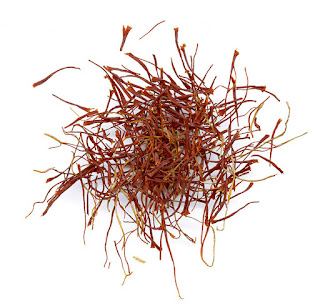I had run out of tea last week and purchased a box of Spanish tea off the display highlighting The World of Spain flavors.
It was a saffron tea, different huh! Not one to pass up an adventure I brewed a pot and reflected on my recent escapade to Spain. It is good tea, tastes brilliant with cream and sugar. There is a shimmer almost out of reach that is exotic in the aroma and taste. I became a bit more curious about this saffron. I use it when I make rice, adding a few strands to add color and that shimmer of exotic. What is saffron? How and why has it been used for centuries? It is expensive to buy and there are only a few strands in the package. I was given a box of delicate saffron threads for a gift once. I loved it. It was a perfect exotic gift for me. I felt adored.
Saffron, those threads of reddish orange that are highly prized are the stigmas, the long thin thread that generates the pollen, on a flower. Specifically the Saffron Crocus. There are usually four blossom per plant and three stigmas per blossom. This is why it is one of the worlds most costly spices.
It was first cultivated in Greece and first found growing on Crete and the Persians were the first to write about it in recipes. It grows well in the chaparral environment of California, Greece and Spain.
The Assyrians used saffron as part of the ingredients to treat about 90 ailments including melancholy, asthma, insomnia, heartburn, and baldness. Saffron was well known for its use as an aphrodisiac. Having drank this saffron tea for a week now I can assure you that I am NOT bald but neither am I a raging nymphomaniac. Alexander the Great bathed in saffron after battles because it was known to have healing properties. It has been used medically for thousands of years. Egyptians used it in perfumes. The aroma is honey, slightly metallic and sweet hay. Cleopatra bathed in it regularly and Greek courtesans used it in their perfumes, scented waters and mascaras.
Robes of Buddhist monks were originally dyed with saffron but as it was so expensive turmeric became a better option.
With all this bathing going on does this mean I am drinking the bathwater ingredients of Royalty? Disturbing.....
Saffron was used medicinally during the 14th century Black Plague (I have not come down with the plague either) and was in such demand and so precious it quickly became the most sought after prize by Pirates. In Nuremberg a law, Safranschou code made the theft of saffron punishable by fine, imprisonment and even execution. The value of a shipment from Rhodes in today's dollars would be valued at over $500,000.00.
By 1730, thanks to the Pennsylvania Dutch colonists American saffron's list price on the Philadelphia commodities exchange was equal to gold where it remained until after 1812.
Maybe I should stock up on this treasure. You will soon know me as the Saffron Baroness. Tamara de Saffron. I like it!!!







No comments:
Post a Comment